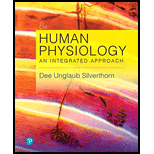
Concept explainers
The three types of muscle tissue found in the human body are ______, ______, and ______. Which type is attached to the bones, enabling it to control body movement?
Introduction: The main objective of muscles is to support the locomotion or movement of an organism. The muscle tissues form the muscular system of the body which is responsible for the various activities that are performed by an organism.
Answer to Problem 1RQ
Correct answer: The three types of muscle tissue found in the human body are smooth, cardiac, and skeletal.
Explanation of Solution
The basic structural unit that constitutes the whole network of muscle is known as a sarcomere. The three types of muscle tissues, which are found in the human body, are skeletal, smooth, and cardiac muscles. The basic structure of these muscles is given below:
- Smooth muscles:
These muscles are involuntary in nature and form the supporting tissues of internal organs, intestine, stomach, and blood vessels.
- Cardiac muscles:
The cardiac muscles are the specific muscles of the heart. These muscles supply blood to the heart.
- Skeletal muscles:
Skeletal muscles are striated voluntary muscles which are under the control of “somatic nervous system (SNS).” These muscles are present in a direct contact with the skeleton.
The three types of muscle tissues which are found in the human body are smooth, skeletal, and cardiac muscle.
To determine: The type of muscle which is attached to the bones and enables to control the body movement.
Introduction: The movement of muscles takes place by the process of muscle contraction. In this process, the protein filaments of muscles which are myosin and actin slide over each other to perform the process of movement.
Explanation of Solution
The movement of the body is controlled by the skeletal muscles of the body. These muscles are attached to the bones and support the voluntary movements of the body. The skeletal muscles are controlled by the somatic nervous system (SNS) of the body.
Skeletal muscles are attached to the bones for the movement of the body.
Want to see more full solutions like this?
Chapter 12 Solutions
EBK HUMAN PHYSIOLOGY
- Answer in step by step with explanation. Don't use Ai and chatgpt.arrow_forwardIdentify the indicated cavity (Fucus). a. antheridia b. conceptacel c. receptacle d. oogonium e. none of thesearrow_forwardIdentify the indicated structure (Saprolegnia). a. antheridium O b. oospore c.sperm d. auxospore e. tetraspore Of. zygosporearrow_forward
- Using information from the primary literature (several references have been provided as a starting point below) please answer the following question: Based on your review of the literature on rewilding, what are the major scientific pros and cons for rewilding? Please note that the focus of this assignment are the (biological) scientific issues associated with rewilding. As will be discussed in class, there are a number of non-scientific issues involved or implicated in rewilding, all ultimately affecting the public acceptability of rewilding. Although these issues are important – indeed, critical – in this assignment you should focus on the biological science issues and questions. Details: You must enumerate at least two pros and at least two cons. Your answer should be no more than 500 well-chosen words, excluding references. Think carefully about how best to organize and structure your answer. Aim for high information density: say a lot, but say it succinctly. Recall Nietzche’s…arrow_forwardUsing information from the primary literature (several references have been provided as a starting point below) please answer the following question: Based on your review of the literature on rewilding, what are the major scientific pros and cons for rewilding? Please note that the focus of this assignment are the (biological) scientific issues associated with rewilding. As will be discussed in class, there are a number of non-scientific issues involved or implicated in rewilding, all ultimately affecting the public acceptability of rewilding. Although these issues are important – indeed, critical – in this assignment you should focus on the biological science issues and questions. Details: You must enumerate at least two pros and at least two cons. Your answer should be no more than 500 well-chosen words, excluding references. Think carefully about how best to organize and structure your answer. Aim for high information density: say a lot, but say it succinctly. Recall Nietzche’s…arrow_forwardNow draw a rough sketch of what the control data might look like if in addition to the specific binding, there was also a considerable amount of nonspecific binding (again using a normal dose/response curve) (do % total bound ligand vs concentration)arrow_forward
- What are functions of cuboidal cells in the kidney? Select all that apply. Concentration of gases Dilution of chemicals Secretion of molecules Nutrition to tissues Support of tissues Absorption of moleculesarrow_forwardquestion1 In plants, epithelial tissue is only found as the outermost cell layer and acts as a barrier. In humans, epithelial tissue is found inside the body as well as on the surface. What function(s) does/do epithelial tissue carry out in humans? Select all that apply. Waste storage Filtration Oxygen transport Protection Diffusion Osmosis Absorptionarrow_forwardWhat words best describes this organism? a. Unicellular/nonmotile Ob. unicellular/motile c. colonial/nonmotile d. colonial/motile e. multicelluar O f. siphonous g. none of thesearrow_forward
 Human Biology (MindTap Course List)BiologyISBN:9781305112100Author:Cecie Starr, Beverly McMillanPublisher:Cengage Learning
Human Biology (MindTap Course List)BiologyISBN:9781305112100Author:Cecie Starr, Beverly McMillanPublisher:Cengage Learning Human Physiology: From Cells to Systems (MindTap ...BiologyISBN:9781285866932Author:Lauralee SherwoodPublisher:Cengage Learning
Human Physiology: From Cells to Systems (MindTap ...BiologyISBN:9781285866932Author:Lauralee SherwoodPublisher:Cengage Learning
 Biology 2eBiologyISBN:9781947172517Author:Matthew Douglas, Jung Choi, Mary Ann ClarkPublisher:OpenStax
Biology 2eBiologyISBN:9781947172517Author:Matthew Douglas, Jung Choi, Mary Ann ClarkPublisher:OpenStax





